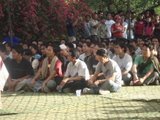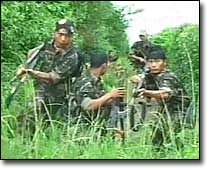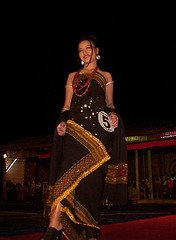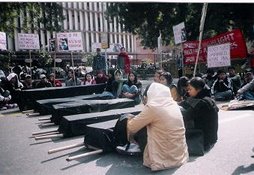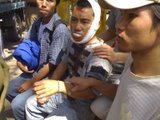Memorandum Submitted to Prime Minister Rajiv Gandhi by the Manipur Kuki Tribes recognition Demand Committee on April 28, 1987
On April 28, 1987, the Kuki Tribes recognition Demand Committee, Manipur, submitted a memorandum to the then Prime Minister Rajiv Gandhi for inclusion of the Kuki Tribes in the Indian Constitution’s list of Scheduled Tribes by an Act of Parliament. Presented below is the text of the memorandum:
Memorandum Submitted to Shri Rajiv Gandhi, Prime Minister of India by the Manipur Kuki Tribes recognition Demand Committee on April 28, 1987
Hon’ble Sir
The Manipur Kuki Tribes Recognition demand Committee deemed it to be a golden privilege to submit this Memorandum to your good office while your Government is revising the lists of Scheduled Tribes in the country.
Historically, Kukis are one of the two major tribes of Manipur; contributing many valuable lives for the cause of our country from the foreign yoke during the 1917-1919 against the British rule in Manipur now known as KUKI REBELION.
The Kukis further fought and extended their utmost possible help during the II World war against the British regime in the country by joining the Indian National Army. In recognition and token of which more than one hundred Kukis are awarded freedom Fighters Pension. The recorded history of Assam Regiment and Assam Rifles which are the evidences of the services rendered by the Kukis may also kindly be referred to and recalled.
At present there are six notable organisations of the Kukis viz., the Kuki War Memorial Committee, the Kuki National Assembly (a recognised Regional political party), the Kuki Bapist Convention, the Kuki Christian Association, the Kuki Christian Church and the Kuki Students Organisation which stand for the Kuki community with a population of nearly one and half lakh though the Tribal Bench Mark survey 1983 recorded Kukis population at 85,000 approximately.
Since the deletion of Kuki Tribes in the Constitution (Scheduled Tribes) Order 1956 in respect of the state of Manipur in modification of Scheduled tribes order 195`1, no Kuki had been allowed to contest the lone Lok Sabha seat in Manipur, the 19 Assembly scheduled Tribes seats and the District Council seats in Manipur reserves for the said Scheduled Tribe candidates.
The Kuki leaders submitted several representations and Memorandums to the State Government and Union Government from time to time urging for the inclusion of Kukis in the Constitution of scheduled Tribes lists but the representations and Memorandums were paid a deaf ear till date.
That Mr Rishang Keishing, Chief Minister, Manipur has informed the house on 11-03-1987 in his written reply statement to Starred Question No. 1188 asked by Shri O, Joy Singh, MLA, stated that the Kukis were not a recognised Scheduled Tribe in Manipur and also that there were no vacancies for them, but Scheduled Tribes/Scheduled Castes candidates might compete any general seats and ignored several memoranda submitted to his good office. He further stated that there was no proposal to recommend Kukis for inclusion in the list of Scheduled Tribes.
In fact, No Kuki student from Manipur are admitted against any reserved seats in Medical and Engineering Colleges so far in any Indian University/Institution.
No Kuki Student has been granted Scholarship from Manipur.
No Kuki candidates are considered against any post and services of vacancies reserved for the Tribals of Manipur while the entire Kuki population is included in the fixation of reservetion of seats for Scheduled Tribes to the total Manipur population, which we never enjoyed.
No Kuki is benefited from the Directorate for Development of tribals & Backwards Classes, Government of Manipur though the entire Kuki population is included in their Plan and Budgets.
Kukis are included in the Constitution of Scheduled Tribes Lists orders for the States of :—
(1) Nagaland
Annexure –A
(2) Assam
Annexure –B
(3) Meghalaya
Annexure –C
(4) Mizoram
Annexure –D
(5) Tripura
Annexure –E
The Kuki Tribes are included in the above States under the heading of "Any Kuki Tribes including" which meets the purpose and demands of the community in the concerned states.
The Constitution Scheduled tribes List Modification Order 1956 (Manipur) does not include the Kuki tribes name at all but some of the Kuki sub-tribes are recognised as separate Tribes such as (1) Amol (2) Chiru (3) Chothe (4) Gangte (5) Hmar (6) Kom (7) Paite (8) Purum (9) Ralte (10) Simte (11) Sukte (12) Thadon (13) Vaiphei and (14) Zou by lenving some other Kuki sub-tribes such as (1) Baite (2) Biate/Biete (3) Chongloi (4) Doungel (5) Guite (6) Hangshing (7) Haokip (8) Khongsai (9) Kipgen (10) Manlun-Manchong (11) Mate (12) Milnem (13) Neihchiel (14) Tiddim Chin (15) Touthang (16) Tungdim.
Now, in the conclusion, the Manipur Kuki Tribes Recognition demand Committee urge to include the Kuki Tribes in the Constitution of scheduled Tribes lists by an Act of Parliament as we understand now under revision as follows under the common nomenclature of its ethnic groups of people as in the cases of neighbouring states cited in the above pares to meet the demands of the community and in the common pattern of neighbouring States:—
ANY KUKI TRIBES INCLUDING :—
1। Aimol 2. Baite 3. Biate/Biete 4. Chiru 5. Chothe 6. Chongloi 7. Doungel 8. Gangte 9. Guite 10. Hangshing 11. Haokip 12. Hmar 13. Khongsai 14. Kipgen 15. Kom 16. Maniun Mancheng 17. Mate 18. Milhem 19. Neihchiel 20. Parte 21. Purum 22. Ralte 23. Simte 24. Sukte 25. Tiddim Chin 26. Thadou 27. Touthang 28 Tungdim 29 vaiphei 30. Zou.
The Manipur Kuki Tribes Recognition of Demand Committee shall welcome your good service to the inclusion of the KUKIS in the Constitution of the Scheduled Tribes lists to end the 30 year old exploitation in the State of Manipur।
(HAOKHOTHANG BAITE)
President,Manipur Kuki TribesRecognition Demand
(YAMTHANG HAOKIP)
Secretary,Manipur Kuki TribesRecognition Demand
Copy to :—
1. Union Minister,Government of India, New Delhi
2. Union Minister of states,Government of India, New Delhi
3. Union Deputy Minister for welfare,Govt of India, New Delhi.
4. The Chairman, Welfare on SC/ST Commission,Government of India, New Delhi.
5. The Secretary (Tribal Development)Ministry of Home Affairs,Department of Tribal Development,Government of India, New Delhi.
6. The governor of Manipur,Raj Bhavan, Imphal
7. The Chief Minister Manipur, Imphal.
8. Cabinet Minister, Manipur, Imphal
9. The Minister of State (Tribal Development),Manipur, Imphal.
10. The Chief Secretary,Government of Manipur, Imphal.
11. The Secretary (Tribal Development),Government of Manipur, Imphal.
Annexure – A
The Constitution (Nagaland) Scheduled Tribes Order, 1970
[Minister of Law Notification No. G.S.R 1099, dated the 23rd July, 1970, Gazette of India, Extraordinary, 1970, Part II, Section 3 (i) page 641]
The Schedule
Naga
Kuki
Kachari
Mikir
Garo
Annexure – B
The Constitution (Scheduled Tribes) Order, 1950
[Published in the Gazette of India Extraordinary No. 40, New Delhi, Wednesday, September 6, 1950 S.R.O 510]
The Schedule
Part – 1 Assam
1. In the autonomous districts :—
1. Chakma 2. Dimasa, Kachari 3. Garo 4. Hajong 5. Hmar 6. Khasi, Jaintia, Synteng, Pnar, War Bhoi, Lyngngam 7. Any Kuki Tribes, including :—
(i) Biate, Biete
(xx) Kuki
(ii) Changsen
(xxi) Lengthang
(iii) Chongloi
(xxii) Lhangum
(iv) Doungel
(xxiii) Lhoujem
(v) Gamslhou
(xxiv) Lhouvum
(vi) Gangte
(xxv) Lupheng
(vii) Guite
(xxvi) Mangjel
(viii) Hanneng
(xxvii) Misao
(ix) Haokip, Haupit
(xxviii) Riang
(x) Haolai
(xxviv) Sairhem
(xi) Hengna
(xxx) Seinam
(xii) Hongsungh
(xxxi) Singson
(xiii) Hranggkhwal, Rangkhol
(xxxii) Sithou
(xiv) Jongbe
(xxiii) Sukte
(xv) Khawchung
(xxxiv) Thado
(xvi) Khawathlang, Khothalong
(xxxv) Thangngeu
(xvii) Khelma
(xxxvi) Uibuh
(xviii) Kholhou
(xxxvii) Vaiphei
(xix) Kipgen
8। Lakher 9. Man (Tai Speaking) 10. Any Mizo (Lushai) tribes 11. Mikir 12. Any Naga tribes 13. Pawi 14. Synteng.
Annexure – C
[Published in the Gazette of India Extraordinary No. 40, New Delhi, Wednesday, September 6, 1950, S.R.O. 510 lead with Act 81 of 1971 and Act 108 of 1976]
The Schedule
Part – XI Meghalaya
1. Chakma 2. Dimasa, Kachari 3. Garo 4. Hajong 5. Hmar 6. Khasi, Jaintia, Synteg, Pnar, War Bhoi, Lyngngam 7. Any Kuki Tribes, including :—
(i) Biate, Biete
(xx) Kuki
(ii) Changsen
(xxi) Lengthang
(iii) Chongloi
(xxii) Lhangum
(iv) Doungel
(xxiii) Lhoujem
(v) Gamslhou
(xxiv) Lhouvum
(vi) Gangte
(xxv) Lupheng
(vii) Guite
(xxvi) Mangjel
(viii) Hanneng
(xxvii) Misao
(ix) Haokip, Haupit
(xxviii) Riang
(x) Haolai
(xxviv) Sairhem
(xi) Hengna
(xxx) Seinam
(xii) Hongsungh
(xxxi) Singson
(xiii) Hranggkhwal, Rangkhol
(xxxii) Sithou
(xiv) Jongbe
(xxiii) Sukte
(xv) Khawchung
(xxxiv) Thado
(xvi) Khawathlang, Khothalong
(xxxv) Thangngeu
(xvii) Khelma
(xxxvi) Uibuh
(xviii) Kholhou
(xxxvii) Vaiphei
(xix) Kipgen
8। Lakher 9. Man (Tai Speaking) 10. Any Mizo (Lushai) tribes 11. Mikir 12. Any Naga tribes 13. Pawi 14. Synteng.
Annexure – D
The Constitution (Scheduled Tribes) (Union Territories) Order 1951 [Ministry of Law Notification No. C.O. 33, dated the 20th September, 1951, Gazette of India, Territory 1951, Part II, Section 3, Page 1198 G]
The Schedule
Part – II Mizoram
Throughout the Union Territory
1. Chakma 2. Dimasa, Kachari 3. Garo 4. Hajong 5. Hmar 6. Khasi, Jaintia, Synteg, Pnar, War Bhoi, Lyngngam 7. Any Kuki Tribes, including :—
(i) Biate, Biete
(xx) Kuki
(ii) Changsen
(xxi) Lengthang
(iii) Chongloi
(xxii) Lhangum
(iv) Doungel
(xxiii) Lhoujem
(v) Gamslhou
(xxiv) Lhouvum
(vi) Gangte
(xxv) Lupheng
(vii) Guite
(xxvi) Mangjel
(viii) Hanneng
(xxvii) Misao
(ix) Haokip, Haupit
(xxviii) Riang
(x) Haolai
(xxviv) Sairhem
(xi) Hengna
(xxx) Seinam
(xii) Hongsungh
(xxxi) Singson
(xiii) Hranggkhwal, Rangkhol
(xxxii) Sithou
(xiv) Jongbe
(xxiii) Sukte
(xv) Khawchung
(xxxiv) Thado
(xvi) Khawathlang, Khothalong
(xxxv) Thangngeu
(xvii) Khelma
(xxxvi) Uibuh
(xviii) Kholhou
(xxxvii) Vaiphei
(xix) Kipgen
8। Lakher 9. Man (Tai Speaking) 10. Any Mizo (Lushai) tribes 11. Mikir 12. Any Naga tribes 13. Pawi 14. Synteng.
Annexure – E
The Constitution (scheduled Tribes) Order, 1950 [Published in the gazette of India Extraordinary No. 40, New Delhi, Wednesday, September 6, 1950, S.R.O. 510 read with Act 81 of 1971 and act 108 of 1976]
The Schedule
Part – XV Tripura
1. Bhil 2. Bhutia 3. Chaima 4. Chakma 5. Garoo 6. Halam 7. Jamatia 8. Khasia 9. Kuki, including the following sub-tribes
(i) Balte
(x) Laifang
(ii) Belalhut
(xi) Lentei
(iii) Chhalya
(xii) Mizel
(iv) Fun
(xiii) Namte
(v) Hajango
(xiv) Paitu, Paite
(vi) Jangtei
(xv) Rangchao
(vii) Khteng
(xvi) Rangkhole
(viii) Khephong
(xvii) Thangluya
(ix) Kuntei
10. Lepcha 11. Lushai 12. Mag 13. Munda, Kaur 14. Noatia 15. Orang 16. Riang 17. Santal 18. Tripura, Tripuri, त्रिप्पेरा
Annexure – F
THE CONSTITUTION (SCHEDULED TRIBES)(PART C STATES) ORDER, 1951
The Schedule
Part VI – Manipur
Throughout the State
1. Any Kuki Tribe 2. Any Lushai Tribe 3. Any नागा
The Schedule
Part VI – Manipur
Throughout the State
1. Any Kuki Tribe 2. Any Lushai Tribe 3. Any नागा
Annexure –G
The constitution Scheduled Caste and Scheduled Tribes Lists (Modification) Order, 1956
Part X, - Manipur
1। Aimol 16. Mariang
2। Anal 17। Any Mizo (Lusbai) tribes
3। Angami 18. Monsang
4। Chiru 19. Mayon
5। Chothe 20. Paite
6। Gangte 21. Purum
7। Hmar 22. ralte
8। Kabui 23. Sema
9. Kacha-Naga 24. Simte
10। Koirao 25. Suhte
11। Koireng 26. Tangkhul
12। Kom 27. Thadou
13। Lamgang 28. Vaiphei
१४ 29। Zou
15. Maram
Part X, - Manipur
1। Aimol 16. Mariang
2। Anal 17। Any Mizo (Lusbai) tribes
3। Angami 18. Monsang
4। Chiru 19. Mayon
5। Chothe 20. Paite
6। Gangte 21. Purum
7। Hmar 22. ralte
8। Kabui 23. Sema
9. Kacha-Naga 24. Simte
10। Koirao 25. Suhte
11। Koireng 26. Tangkhul
12। Kom 27. Thadou
13। Lamgang 28. Vaiphei
१४ 29। Zou
15. Maram






